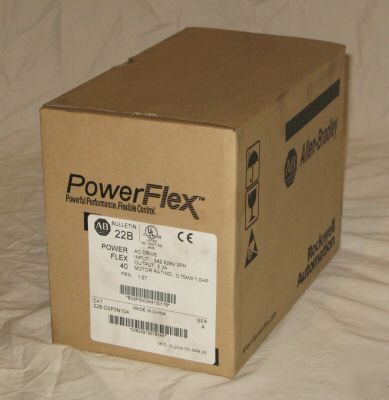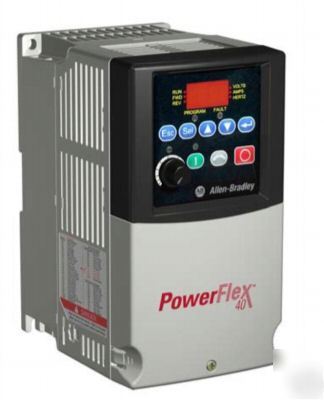Oak Bluffs, MA old classifieds archive and funnies > By Year
> 2002
> Powerflex 40 (22B-D010N104 ) 5HP, 480V,
Powerflex 40 (22B-D010N104 ) 5HP, 480V,
Start Up, Programming and Operation
• An integral keypad provides out of the box operation using the local potentiometer and control keys.
• The 10 most common application parameters are contained in the Basic Program Group, making programming fast and easy.
• The programming keys have the same function as all other PowerFlex drives, so if you can program one PowerFlex drive, you can program them all.
• 4 digit display with 10 additional LED indicators provides an intuitive display of drive status and information.
• Integral RS-485 communications can be used for programming from a PC. It can also be used in a multi-drop network configuration. A serial converter module provides connectivity to any controller with a DF1 port.
• A NEMA/UL Type 4X remote and NEMA/UL Type 1 hand-held LCD keypad provide additional programming and control flexibility, both featuring the popular CopyCat function.
• Removable MOV to ground provides trouble-free operation when used on ungrounded distribution systems.
• A relay pre-charge limits inrush current.
• Integral brake transistor, available on all ratings (except no brake version), provides dynamic braking capability with simple low cost brake resistors.
• DIP switch settable 24V DC sink or source control for control wiring flexibility.
• 150% overload for 60 seconds or 200% overload for 3 seconds provides robust overload protection.
• Adjustable PWM frequency up to 16 kHz ensures quiet operation.
• Sensorless Vector Control provides exceptional speed regulation and very high levels of torque across the entire speed range of the drive.
• The Autotune feature allows the PowerFlex 40 to adapt to individual motor characteristics.
• At 100% motor load, the drive will run the motor at synchronous speed.
• Excellent current regulation.
• Best in class digital input response time and repeatability.
• Sensorless Vector Control develops high torque over a wide speed range and adapts to individual motor characteristics.
• Variable PWM allows the drive to output more current at low frequencies.
• Integral PID functionality enhances application flexibility.
• Timer, Counter, Basic Logic and StepLogic™ functions can reduce hardware design costs and simplify control schemes.
- Timer function: Relay or opto outputs controlled by drive performing timer function. Timer is initiated by activating a digital input programmed as “Timer Start.â€
- Counter function: Relay or opto outputs controlled by drive performing counter function. Counter function is activated by a digital input programmed as “Counter Input.â€
- Basic Logic: Relay or opto outputs controlled by status of digital inputs programmed as “Logic Inputs.†Performs basic Boolean logic.
- StepLogic: Logic-based steps using preset speed settings. Each step can be programmed for a specific speed, direction and accel/decel profile. Drive outputs can be used to indicate which step is being performed.
• Two (2) Analog Inputs (one unipolar and one bipolar) are independently isolated from the rest of the drive I/O. These inputs can be toggled between via a digital input.
• Three (3) fixed and four (4) fully programmable Digital Inputs provide application versatility.
• One (1) Analog Output is DIP switch selectable for either 0-10V or 0-20mA. This scalable, 10-bit output is suitable for metering or as a speed reference for another drive.
• Two (2) Opto Outputs and one (1) form C relay output can be used to indicate various drive, motor or logic conditions.
• The control logic is 24V DC and can be set for either Sink or Source control via a DIP switch setting.
• Control terminal screws are sized for a conventional blade screw driver.
• I/O Terminals 1, 2 and 3 are dedicated for Stop, Start and Reverse operation respectively. These I/O Terminals can be programmed for 2- or 3-Wire operation to meet application requirements.
• I/O Terminals 5, 6, 7 and 8 are programmable and provide added flexibility. Programmable functions include Local Control, Jog, Second Accel/Decel, Clear Fault, Preset Frequencies, RS485 Control and Auxiliary Fault.
• Speed can be controlled via a 0-10V input and/or 4-20 mA input. Both inputs are independently isolated from the rest of the drive and can be used for applications such as PID. Voltage input can be programmed for bipolar operation.
• Integral communication cards such as DeviceNet™, EtherNet/IP™, PROFIBUS™ DP, LonWorks® and, ControlNet™ can improve machine performance.
• The DSI Wireless Interface Module (WIM) provides a wireless communication interface between a Pocket PC, laptop computer or desktop computer equipped with Bluetooth® wireless technology, and any Allen- Bradley® product supporting the DSI™ protocol.
• Field installed option allows for future addition of stand-alone drives to a network.
• Online EDS file creation with RS NetWorx™ providing ease of set-up on a network.



